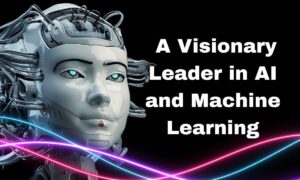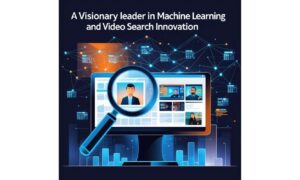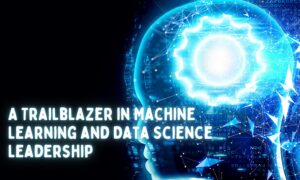Technology is no longer just a tool but an intelligent companion that empowers us in unimaginable ways. From self-driving cars to virtual assistants that understand our every command, artificial intelligence (AI) and machine learning have rapidly transformed the way we live, work, and interact with the digital realm. But what exactly are AI and machine learning? How do they differ from each other? And most importantly, how can they revolutionize our lives?.
Introduction to Artificial Intelligence (AI):
Artificial Intelligence (AI) is a rapidly evolving field of computer science that focuses on creating intelligent machines that can think, learn, and perform tasks normally requiring human intelligence. It is a branch of computer science that aims to build smart machines capable of performing advanced cognitive functions such as problem-solving, decision-making, pattern recognition, and natural language processing.
The concept of AI has been around for decades, but it has recently gained more attention due to advancements in technology and the increasing use of automation in various industries. From self-driving cars to virtual assistants like Siri and Alexa, AI has become a significant part of our daily lives.
But what exactly is AI? In simple terms, AI refers to the simulation of human intelligence in machines programmed to mimic human actions and thought processes. This involves developing algorithms that enable computers or machines to learn from data inputs, recognize patterns, make decisions with minimal human intervention.
Definition and Explanation of Machine Learning (ML)
Machine learning (ML) is a subset of artificial intelligence (AI) that involves the development of algorithms and statistical models to enable computer systems to learn from data, identify patterns, and make decisions or predictions without explicit instructions. In other words, it allows machines to learn and improve their performance through experience.
The concept of machine learning can be traced back to the 1950s when researchers started exploring ways to make computers self-learning. However, due to limitations in computing power and availability of large datasets, progress in this field was slow. It wasn’t until the late 1990s and early 2000s that advancements in technology and the rise of big data made machine learning more feasible.
At its core, machine learning relies on three key components: algorithms, data, and feedback. The algorithms are a set of rules or instructions that guide the system’s behavior based on the input data. These algorithms are designed to adjust themselves as they receive more data or feedback from previous experiences.
Data plays a crucial role in ML as it serves as fuel for these algorithms. The more relevant and diverse the data is, the better the system can perform. This is why most companies invest heavily in collecting vast amounts of data from various sources such as sensors, user interactions, social media platforms, etc., for their ML applications.
Understanding the Relationship Between AI and ML
The relationship between artificial intelligence (AI) and machine learning (ML) is often a topic of confusion. Many people use the terms interchangeably, but they are actually two distinct concepts that work together to achieve intelligent automation.
In simple terms, AI refers to the broader concept of creating intelligent machines or systems that can mimic human intelligence. It involves developing algorithms and techniques that enable machines to perform tasks that typically require human intervention. On the other hand, ML is a subset of AI that focuses on giving computers the ability to learn from data without being explicitly programmed.
To understand the relationship between AI and ML, it’s important to first understand how they work individually. Let’s dive deeper into each concept.
Artificial Intelligence:
At its core, AI is about solving problems and making decisions based on past experiences or data. This can be achieved through various methods such as rule-based systems, symbolic reasoning, and statistical approaches. The end goal of AI is to create machines with cognitive abilities like perception, reasoning, problem-solving, and decision-making.
Two Types of Artificial Intelligence:
- Weak/Narrow AI: Also known as narrow or weak AI, this type focuses on performing specific tasks within a limited scope. Examples include image recognition software or chatbots used for customer service.
- Strong/General AI: This type aims at building intelligent systems that can perform any intellectual task just like humans do. It involves creating machines with consciousness and self-awareness.
Machine Learning:
ML takes a different approach compared to traditional programming methods. Instead of writing code for specific instructions, ML algorithms are designed in such a way that they can automatically learn from data inputs provided by humans or generated by themselves through experience. The more data these algorithms are exposed to; the better they become at performing tasks accurately without any explicit instructions. While AI involves creating intelligent systems capable of performing complex tasks similar to humans.
The terms “artificial intelligence” (AI) and “machine learning” (ML) are often used interchangeably, but they refer to distinct concepts with unique capabilities. While both involve the use of technology to mimic human cognitive processes, there are some key differences between AI and ML that set them apart.
- Definition and Scope: AI refers to the broader concept of machines performing tasks in a way that would require human intelligence. This includes problem-solving, decision making, pattern recognition, and natural language processing. On the other hand, ML is a subset of AI that focuses on teaching machines how to learn from data without explicit programming.
- Learning Capabilities: One of the main differences between AI and ML lies in their learning capabilities. Traditional AI systems are programmed with specific rules and logic to perform certain tasks or solve problems. They rely on pre-defined algorithms and do not have the ability to learn from new data or adapt to changing situations. In contrast, ML models can improve their performance over time by continuously analyzing data patterns and adjusting their algorithms accordingly.
- Data Dependency: Another crucial difference between AI and ML is their reliance on data for decision making. While both technologies use data as input, AI systems require structured and labeled datasets to function properly. These datasets are designed by experts who define all possible inputs and outputs for a particular task or problem. In comparison, ML models can work with unstructured data sets without needing any labels or predefined rules.
Real-life Applications of AI and ML
In recent years, artificial intelligence (AI) and machine learning (ML) have become buzzwords in the tech industry. From virtual assistants like Siri and Alexa to self-driving cars and predictive algorithms, the potential applications of these technologies seem endless. But what exactly are some real-life use cases for AI and ML? Let’s take a deeper dive into some of the most impactful applications of these cutting-edge technologies.
- Image and voice recognition: One of the most widely recognized applications of AI and ML is image and voice recognition. These technologies allow computers to recognize patterns in visual or audio data, enabling them to accurately identify objects in images or understand human speech commands. This has been used in various industries such as healthcare, where doctors can use image recognition software to diagnose medical conditions from scans or X-rays with greater accuracy.
- Natural language processing: Natural language processing (NLP) is a subset of AI that deals with understanding and analyzing human language. NLP systems are used in chat-bots, virtual assistants, translation tools, sentiment analysis for social media monitoring, and even email spam filters. With NLP, machines can process large amounts of text data efficiently while also understanding context and sentiment.
- Predictive analytics: Predictive analytics involves using historical data to make predictions about future events or behaviors. This technology uses algorithms based on statistical modeling techniques to analyze vast amounts of data quickly and accurately predict outcomes or trends. Businesses across various industries use predictive analytics for tasks like forecasting sales figures, anticipating customer
Benefits of AI and ML in Various Industries
Artificial Intelligence (AI) and Machine Learning (ML) have become buzzwords in recent years, with its potential to revolutionize various industries. From healthcare and finance to manufacturing and retail, the use of AI and ML is rapidly expanding into every sector. In this section, we will explore the benefits of AI and ML in some of these industries.
- Healthcare: In the healthcare industry, AI and ML are being used for early disease detection, personalize treatment plans, medical image analysis, drug discovery, and patient monitoring. With the help of predictive analytics algorithms, doctors can identify high-risk patients before any symptoms are manifested. This not only leads to better outcomes but also reduces healthcare costs for both patients and providers.
- Finance: The finance industry has been at the forefront of adopting AI and ML technologies. These advanced systems can analyze vast amounts of data in real-time to detect patterns that humans might miss. This helps financial institutions make more accurate predictions about market trends and customer behaviors, resulting in smarter investment decisions. Additionally, fraud detection algorithms powered by AI/ML can save millions for banks by identifying fraudulent activities.
- Manufacturing: The incorporation of AI/ML has led to a significant transformation in the manufacturing sector by enabling predictive maintenance systems that reduce downtimes dramatically. Manufacturers can now monitor their equipment’s performance continuously through sensors connected to an intelligent system that identifies abnormalities or potential failures before they occur.
- Retail: Retail businesses are utilizing AI/ML tools for inventory management; optimizing product recommendations
Potential Risks and Ethical Concerns Surrounding AI and ML
One of the main risks associated with AI and ML is their ability to make decisions without human intervention. This raises concerns about accountability and responsibility for any unintended consequences or errors that may arise from these decisions. For example, in self-driving cars, if an accident occurs due to a malfunction in the AI system, who would be held responsible – the manufacturer, programmer, or owner?.
Conclusion: The Future of AI and ML
As we have explored in this article, artificial intelligence (AI) and machine learning (ML) are rapidly advancing technologies that have the potential to revolutionize various industries, from healthcare to finance. However, with great power comes great responsibility. It is crucial to examine what the future holds for AI and ML, and how these technologies can be used ethically and responsibly.
One of the most significant concerns surrounding AI and ML is the potential impact on job markets. With machines becoming increasingly capable of performing tasks traditionally done by humans, there are valid fears that jobs will become obsolete. While it is true that some jobs may indeed be replaced by automation, it is essential to remember that new jobs will also emerge due to advancements in technology. Instead of eliminating jobs entirely, it is more likely that AI and ML will change the nature of work, requiring individuals to adapt their skills continually.



































